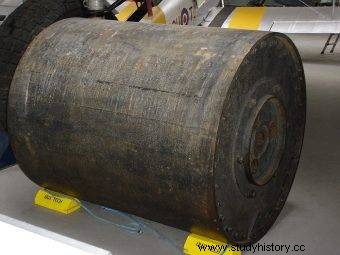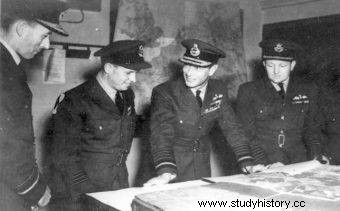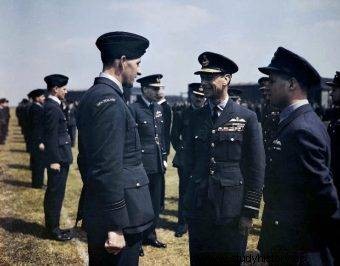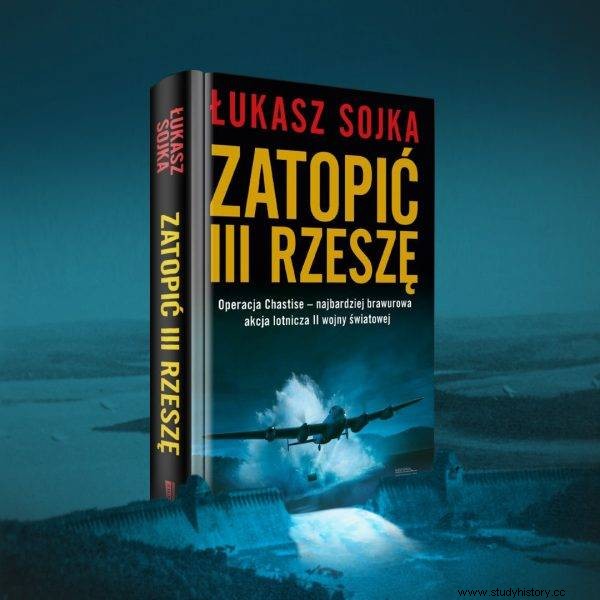On the night of May 16-17, 1943, the Allied bombers completely surprised the enemy, paralyzed the Nazi industry and caused a psychosis of fear in Germany. They strengthened the morale of the Allies and proved to Stalin that the Western Front existed and that the Red Army did not fight alone. Łukasz Sojka, the author of the book "Sunk the Third Reich", talks about the mysterious Chastise operation.
Andrzej Brzeziecki: Operation Chastise, carried out in May 1943 to destroy Germany's dams, had a long history. Barriers were first identified as potential targets as early as 1937, but, as you write, "preliminary analyzes have shown that the Bomber Command has no weapons capable of damaging even massive structures." What finally made the attack possible?
Łukasz Sojka: The attack was made possible by the "Upkeep" bombs - an invention of engineer Barnes Wallis. They were huge steel cylinders weighing over 4 tons, filled with almost 3 tons of Torpex. Rotated and dropped while maintaining appropriate flight parameters, were able to bounce off the water surface, "jump" over anti-torpedo nets, sink after hitting the dam crown and detonate upon contact with its wall at a given depth. Only the explosion of the bomb in contact with the wall guaranteed success.
In fact, why was it so important to destroy these dams?
The goal was really the industry of the Ruhr - the largest conurbation and industrial district of Europe at the time. It was quickly realized that even with very optimistic assumptions about the effectiveness of bombing, shutting down the Ruhr industry by destroying the factories themselves was virtually impossible. That is why it was decided to "shut down" these factories. To begin with, a list of power plants, gas plants and coking plants was compiled, the destruction of which would paralyze the region, but these were small targets and the list was far too long to take such a variant seriously.
Then, for the first time in the planners' discussions, the Mohne dam appeared as a source of electricity. It was a completely missed diagnosis. Although the dam water powered the hydroelectric plant, it provided the Ruhr area with a negligible proportion of its energy consumption.

Original jumping bomb at the Imperial War Museum, Duxford
However, it was soon realized how important the water accumulated by the dam is for the economy of the basin. This, in turn, became the impetus for the search for weapons capable of destroying the dam.
At the time, the use of aviation for strategic purposes, when "military considerations are mixed with political and economic considerations", was a fresh and questionable idea. What were the arguments for and against?
The concept of a war decided by aviation appeared before World War I, although it was initially the domain of science fiction writers. However, as early as 1910, Lord Montagu de Beaulieu spoke of the threat of economic and social collapse if the enemy airship fleet destroyed the country's "nerve centers".
Winston Churchill certainly had his opinion on this issue as well ...
Even before the outbreak of the Great War, Churchill was considering countermeasures against attacks by German airships. As First Lord of the Admiralty, he was also an ardent supporter of aviation expansion.
During World War I, both the Germans and the British used aviation as a strategic weapon. Both nations also learned the hard way what the effects of aerial bombardment are, and drew diametrically different conclusions from this experience.
The bombing of English cities by German airships and later Gotha and Zeppelin-Staaken heavy bombers did not cause material losses that would affect Great Britain's war effort, but came as a shock to the island society.
A similar shock in Germany was not caused by the raids by Handley Page bombers on factories and railway facilities in the Saar Basin, although their effectiveness was similar. In turn, the costs of sending airships and bombers to England were disproportionately high in relation to the achieved results.
Thus, in Great Britain the doctrine of using aviation as an independent type of armed forces operating at a strategic level prevailed, while in Germany the doctrine of the tactical use of air forces in close cooperation with the land forces was adopted. The increase in its popularity was also influenced by the belief that the next war in Europe would be positional - in such a situation it is precisely the bomber fleets that would tip the tide.
When Barnes Nevill Wallis finally created the appropriate bomb, there were still the right planes. The choice fell on Avro Lancasters. What advantages did these machines have?
The Lancasters were undoubtedly the best British bombers of World War II, so one could talk about their advantages for a long time. They had high lifting capacity and excellent performance. Pilots appreciated them for their piloting characteristics - for such a large plane, they reacted very quickly to the movements of the tiller, which was not without significance in the case of a night mission, at a very low altitude, where the pilot had to repeatedly avoid terrain obstacles.
But they also had one specific flaw, although those who found out about it could not, as you write, complain about it to anyone else ...
In the event of being shot down, the entire crew, except for the tail gunner, was to evacuate through one small hatch in the floor of the plane. It took time, which was usually not available in such a situation. Although there was a large door in the tail section, it was positioned so that anyone who attempted to parachute through it would immediately hit the leading edge of the tailplane.
Wing Commander Guy Gibson, one of the main characters of your book, who led 617 Squadron during the attack, was - as you write - “a phenomenon; a man whose bullets didn't seem to work; a daredevil who kept dragging death on his heels by the nose ”. What do we know about him?
Gibson was undoubtedly an extraordinary figure, multidimensional and in many ways tragic. An excellent pilot, but at the same time an almost psychopathic clerk. He fought from September 3, 1939 and during that time (until the 617 Squadron was created) he flew two combat turns on bombers and one on night fighters (he shot down at least 3 German machines).

Air Vice Marshal Ralph Cochrane, Guy Gibson Wing Commander, King George VI and Captain John Whitworth while discussing rally details
He married an older show dancer, with whom he tried to form a normal marriage, although as his wife later recalled - "he married me, but he was married to each subsequent plane" .
According to many, his only real friend was the black Labrador Nigger.
Gibson wrote about his colleagues from the squadron that they were wonderful youth ... doomed to death. Where did the Dambusters come from?
617 squadron - like the whole Bomber Command - constituted a cross section of almost the entire community of the empire. So there were people from all walks of life, the English, Canadians, New Zealanders and Australians, and even one American who decided to join the RAF while his homeland was neutral.
In the pre-war RAF, the division into officers, non-commissioned officers and privates was a reflection of the class structure, and it was usually the origin that determined the receipt of an officer's patent. The war began to change that, but Guy Gibson was extremely conservative on these issues and often treated NCOs and privates quite dismissively.
The pilots themselves were mostly very young - the average age oscillated around 22 - so they had an inexhaustible appetite for life, and life in Bomber Command was very easy to lose . Each return from a combat flight was therefore a cause for celebration, which was also eagerly done in the canteen or local pubs.
The attack was carried out on the night of May 16-17. It's probably a miracle that the planes flew over the target?
The dams that were the target of the operation were located deep in Germany and to reach them, it was necessary to circumnavigate the Ruhr region - the site of the highest concentration of air defense in occupied Europe.
For obvious reasons, it was not possible to fly during the day, and to avoid detection by radars and interception by night fighters, Lancasters of the 617 Squadron had to fly as low as possible - often several meters above the ground. This in turn required constant avoidance of high voltage pylons, chimneys, tall trees and buildings. In order not to crash into them, the crew had to see them - so the raid could only take place on a cloudless night, during a full moon.
On the eve of the operation, there was also an incident that could have a serious impact on its course. Nigger - Gibson's beloved dog - was fatally hit by a car at the entrance to the base. Gibson's associates feared that this news might throw the squadron commander completely off balance when he needed maximum concentration. The more superstitious crew members might also take this as a bad omen.

The text was created, among others based on the book by Łukasz Sojka "Zatopić III Rzeszę", which has just been published by the Znak Horyzont publishing house
In the end, it was decided to hide the matter from the pilots, notifying only Gibson. This - contrary to fears - did not break down and led the squadron into battle.
Was it classic bombing?
The attack itself required extremely strict compliance with the flight parameters. The bomber must have been flying perfectly straight, 60 feet (18.3 m) above the water, at a speed of 232 miles per hour (373 km / h). The flight path also had to be perpendicular to the barrier wall and the bomb was to be released about 500 meters from the target.
The state of the technology at that time meant that all the parameters had to be supervised by the crew members - the bombardier used a simple "trigonometric sight" to assess the distance from the target, the on-board mechanic took care of maintaining the set speed, and the radio operator started the hydraulic motor that set the bomb in motion and regulated its rotational speed.
The biggest problem was keeping a precise height of 60 feet above the water. The barometric altimeters were too inaccurate, and so were the radio altimeters of the time.
The idea of solving this problem came up with Benjamin Lockspeiser - head of the research department at the Ministry of Aviation Production. He was inspired by the experience of detecting U-boats using powerful floodlights. Given that the beams of the headlamps can only intersect at one point, it was sufficient to install two headlamps on the Lancaster deck, the headlamps of which will touch exactly 60 feet below the machine, creating an 8-like shape on the water.
During the attack, the navigator observed the circles of light formed by the floodlights on the water and informed the pilot when they would reach the correct attack ceiling. Of course, the two searchlights turned on were also a great help for the anti-aircraft guns defending the Mohne barrage.
The dams were damaged, but not all - Ennepe has survived. Almost half of the planes did not come back from the mission…
Of the three main targets - two have been destroyed. The Mohne and Eder dams have been breached. The Sorpe Dam has survived, collecting almost a quarter of the water supply for the Ruhr. (Mohne accumulated approx., And Eder did not supply the Ruhr at all, but the Mittelland Canal). In her case, a completely different construction decided - Sorpe was an earth dam that required a completely different method of attack. While in the case of heavy dams such as Mohne and Eder, one precise hit was enough, in the case of Sorpe it was the cumulative effect of as many bombs as possible.

King George VI in conversation with 617 Squadron pilots after returning from the rally
Of the five machines originally aimed at this target, only one dropped the bomb. One Lancaster from the reserve wave, which was directed there already during the flight, also reached Sorpe. Two bombs, however, were not enough to damage the structure to a degree that could destroy it.
Of the backup targets, only one was attacked - the Ennepe Dam was reported to be, although today it seems that it was a rather 8 km distant Bever Dam.
So you can call it a success?
The question of whether Operation Chastise was a success raises emotions to this day - British propaganda used its potential to the fullest from the moment the last bombers returned to Scampton. During the war it was presented as a precisely placed blow, after which the industrial machine of the Third Reich would no longer recover . As we know, however, the war lasted for the next two years and the German industry actually continued until the very end.
The loss of eight of the 19 planes dispatched also worked on the imagination - there were few raids with losses of 42%. For the then commander of the Bomber Command - Arthur Harris - this was a confirmation that precise attacks on industrial "panacea targets" were too costly in relation to the potential gains.
The Ruhr industry suffered the effects of the raid (June and July 1943 were the only wartime months in which steel production in this region fell instead of rising), but it quickly returned to its former tracks. The damaged infrastructure was quickly rebuilt, as were the dams themselves.

The text was created, among others based on the book by Łukasz Sojka "Zatopić III Rzeszę", which has just been published by the Znak Horyzont publishing house
However, it was rather a proof of how important these facilities were for the economy of the Third Reich - to eliminate the effects of the air raid, as less than 30,000 workers from the Todt organization working on the largest European construction site - the Atlantic Wall . Of course, they were not taken from sites most vulnerable to Allied invasion, such as the Pas-de-Calais area, but from Normandy, where an invasion was rather unexpected.
The fate of the Allied landing in France might have been very different if the workers transferred to deal with the effects of Operation Chastise had remained in their posts, completing the Normandy section of the Atlantic Wall.
And what was the long-term significance of Operation Chastise to the future of aviation?
The Upkeep bomb was never used again, but the success of the operation made the RAF decide what to do with the new, elite squadron, which had lost almost half of its state but became a legend.
Various options were considered - including the disbandment of the unit - but in the end it was decided to use the 617 squadron as a kind of "sniper" Bomber Command unit. Until the end of the war, the squadron known as "Dambusters" took part in a series of spectacular missions, among which it is enough to mention the sinking of the battleship Tirpitz or the destruction of long-range V3 gun positions that were to fire at London from the French coast.

Möhne Dam in the morning of May 17 after the bombing
During many of these missions, another invention of Barnes Wallis was used - the Tallboy bomb weighing more than 5 tons, causing a seismic shock destroying even the most resistant bunkers.
If anyone has not heard of Operation Chastise before, then they have come across it ... while watching the famous "Star Wars" by Georg Lucas. What does a historical operation have in common with a movie about a distant galaxy?
Operation Chastise very quickly found its way into Anglo-Saxon pop culture - making a Hollywood film about it was considered already during the war, but the story did not finally hit the silver screen in 1955 thanks to the English film "The Dam Busters" based on the book by Paul Brickhill, as well as of Guy Gibson's war memories.
The film contained many groundbreaking aviation sequences for its time - some real Lancasters, some models, and some special effects. It also turned out to be a box office success, becoming almost a generation experience in Anglo-Saxon countries.
One of his die-hard fans was George Lucas, who, while shooting the epic sequence of attack on the Death Star in the finale of "Star Wars", was very clearly inspired by the movie "The Dam Busters" - starting from the very idea of a precise attack on a very small, but key target, through its course itself, the way it is filmed, and finally the dialogues, which are at times almost literal quotes from an English film. Lucas has also hired Gilbert Taylor, the cinematographer for "The Dam Busters", as the main cameraman.
